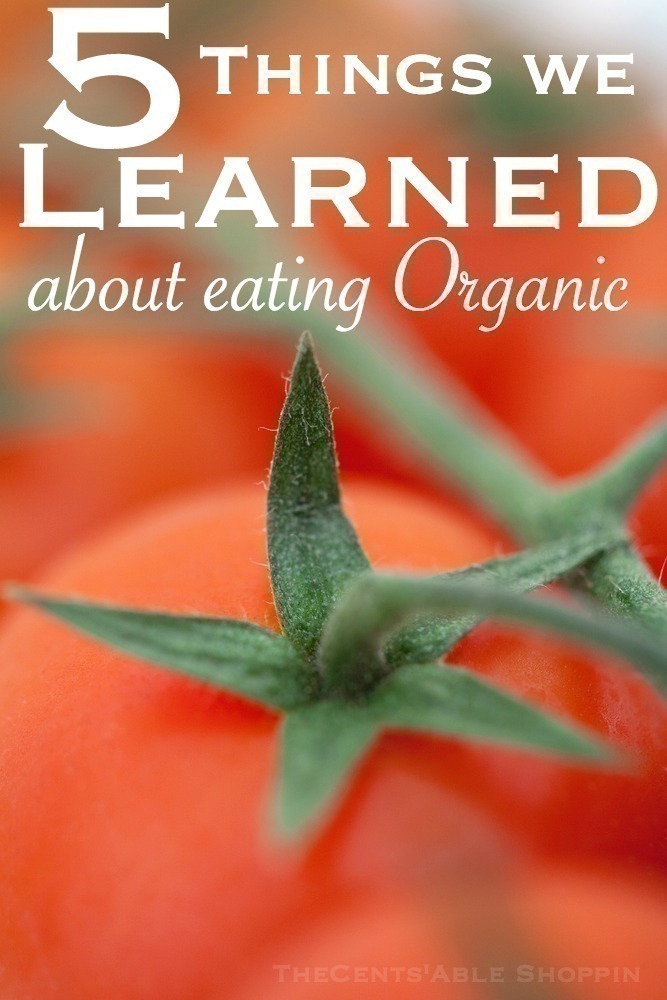
For the last few years, we have all heard that eating Organic is better for you and your family – but little did we know how affordable it REALLY is.
We have always been able to feed our family on a budget – though I will be honest and say anyone (and I mean, ANYONE) can feed their family regular food on a budget. NOT everyone can manage to feed their family Organic food and still know how to save.
I would never tell you that eating Organic can be affordable if it wasn’t.
One of the common misconceptions is that Organic is expensive. I see it all the time… I see people make assumptions on Facebook that mention that Organic food isn’t something that everyone can afford.
It IS something everyone can afford. It’s a matter of reprioritizing … learning how to shop effectively, not being a slave to convenience. The first step? Refraining from saying that it’s not affordable.
Because it IS and can be affordable.
#1 – Know Where to Shop
Buying Organic CAN be expensive – if you shop on a whim. If you shop without a plan. And if you just randomly pop into ANY store, and shop out of the blue.
Knowing where to shop if you frequently purchase organic items is crucial.
Luckily, eating food and feeding your family healthy food does not require making grocery store trips. It does, however, require that you look past the grocery ads and featured sale items which leave a lot to be desired (in most cases). It is NOT necessary to watch sales and price match when you eat organic, either.
We buy as much local certified organic food as possible – from produce to milk we prefer to support our local agriculture over a grocery store. However, we do rely on a monthly trip to Costco to supplement our shopping, too.
Organic Fruits and Veggies are offered at almost every store; however, randomly shopping at any store won’t get you the best deal. By looking outside the grocery store for your purchases (CSA mainly) you can get some great deals.
And although the farmers ranch market may be an option for produce in general, it typically isn’t a reliable place for organic produce (for us, a 15 minute drive to “potentially” find organic produce isn’t a wise use of MY time – same with the 99 Only store .. neither are consistent enough to say they should be relied on).
If you have time to drive to those stores daily then they may be an option for you – but they certainly aren’t for us.
Costco: A GREAT place for MANY organic items. We buy some of our organic produce here, and every month they seem to have more and more. Look at our last post for 20 of the BEST Organic deals to buy at Costco.
Bashas: Not the best place to make Organic purchases – while they recently had Strawberries (Organic) for $1.47 lb, we bought 11 lbs and ended up returning 7 of the 11 pounds … of the 7 we exchanged, 6 of those were STILL moldy. If you are looking for a reliable place to get a great price on Organic food I wouldn’t recommend Bashas – not to mention their organic selection is quite poor compared to other stores.
Walmart: We try to avoid at all costs – while they may have some Organic items, the store is too large and busy for us to even attempt to want to go, and prices on Organic items are generally similar to the other grocery stores. If given the option, we prefer to pay a CSA for produce and support local agriculture, who has more of our interests in mind versus Walmart.
Sprouts: Has some great prices on Organic produce, and non-Organic produce. Knowing what to buy is also critical – the store has knowledgeable employees who will truly go out of their way to help you and answer questions. They have a considerable organic selection – if you don’t have a plan and you shop for Organic on a whim without a plan, you might end up spending more than what you intend to.
Fry’s: Has a small Organic area, and occasional sale on Organic produce. Is it enough to make us wheel the kids in there to shop? Not really – they have the Simple Truth Organic brand, but they often times advertise with the Simple Truth Brand (which is NOT Organic). Their Simple Truth Brand items typically are higher per oz than comparable Organic items at Costco.
WinCo: Although inexpensive, doesn’t scream savings in terms of Organic produce or food in general. Tiny organic selection, not enough to make it our go-to store.
#2 – A CSA is the way to go
Being part of a CSA is not only a great step to take, but it’s cost effective too – you are supporting local agriculture, and receiving an incredible bag of fruits and vegetables for you (single) or your family for a week.
Supporting your local agriculture (farmer) is a great direction to take. They have more of a vested interest in your health than your grocery store.
#3 – Watch your Portion Size
Americans in general have portion sizes that are MUCH too large for what is really needed. In many cases, people may over estimate what is really needed for a family of 4-6 and end up tossing that food or letting it go to waste.
The portions you truly need are often times LESS than what you put on your plate. When you eat organic on a budget, you tend to be more cognizant of what you are eating and are more cautious about waste because (in many cases) the food wasn’t quite as inexpensive as organic varieties.
#4 – Be Selective about what you Buy
It’s always easy to throw a bounty of items in the cart, but without a plan to use that food you are literally throwing money in the trash. One of the lessons you may learn is how to recognize your impulse spending – being wooed by cheap prices that cause you to throw stuff in your cart is fine.. but if that results in more food waste then you might have a problem.
Sometimes, shopping with coupons can lead you to spend more, on items that are not so healthy.
When you invest in a CSA, you receive ONE bag of produce and in some ways it forces you to try things you wouldn’t have normally purchased. We plan our meals around this bag of produce and it works WELL for us. But then again, I love to cook and I prefer to cook over opening a cardboard box.
#5 – Organic requires Effort
While the price of Organic food may seem expensive to some, it really doesn’t have to be that much more. On a cost per oz basis, heavily advertised brand name foods like lunchables and Go-Gurts are often times MORE expensive than their organic equivalents that don’t advertise and may require you to scoop, peel OR slice. Right?
Organic food requires effort. It’s just that simple. Feeding your family whole and real food may seem impossible for some… but what is NOT mentioned is that rather for paying more to avoid the toxic residues and chemical food-like ingredients, people are selling out to buy food items high in convenience.
It’s easier to open a pizza and throw in the oven than it is to chop up some vegetables and make a stir fry.
It’s easier for people to crack open a box of Kids cereal for $1.88 – $2 a box (that is, essentially ALL sugar) than throw a cup of organic Steel Cut Oats in the Instant Pot and feed all of their kids.
Organic foods may not be cheaper than “all” of their conventional counterparts; but there are many conventional foods that are in every corner of the store that are priced much higher organic foods.
It is possible to fill up your shopping cart with a week’s worth of conventional foods and pay MORE than what you would for a week of Organic food – it’s all about choice.



